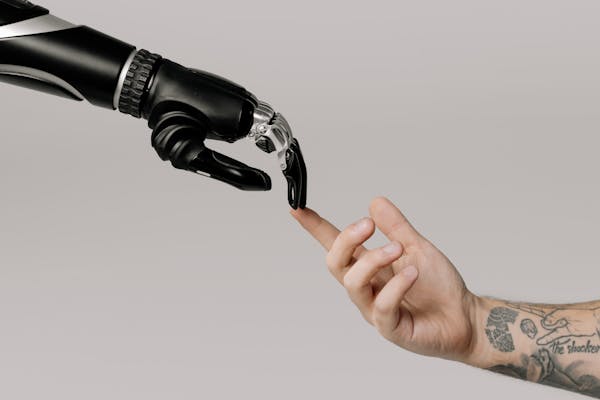
In the ever-evolving landscape of technology, staying ahead of the curve is crucial for businesses, consumers, and tech enthusiasts alike. The pace of innovation continues to accelerate, bringing forth a multitude of new technology trends that promise to revolutionize various sectors. This article delves into some of the most significant new technology trends that are shaping the future, from artificial intelligence and quantum computing to blockchain and biotechnology.
New Technology Trends
1. Artificial Intelligence and Machine Learning
Artificial intelligence (AI) and machine learning (ML) are at the forefront of new technology trends, driving significant advancements across industries. AI refers to the simulation of human intelligence in machines, while ML is a subset of AI that enables systems to learn and improve from experience without being explicitly programmed.
Applications of AI and ML
- Healthcare: AI and ML are transforming healthcare by enabling early diagnosis, personalized treatment plans, and predictive analytics. For instance, AI-powered diagnostic tools can analyze medical images with greater accuracy than human doctors, while ML algorithms can predict patient outcomes based on historical data.
- Finance: In the financial sector, AI and ML are being used for fraud detection, risk assessment, and algorithmic trading. These technologies help financial institutions make more informed decisions and improve operational efficiency.
- Retail: AI-driven chatbots and virtual assistants are enhancing customer experiences by providing personalized recommendations and support. ML algorithms analyze consumer behavior to optimize inventory management and pricing strategies.
Future Prospects
The future of AI and ML looks promising, with advancements in natural language processing, computer vision, and autonomous systems. As these technologies continue to evolve, they will unlock new possibilities in various fields, from smart cities and autonomous vehicles to advanced robotics and personalized education.
2. Quantum Computing
Quantum computing is one of the most exciting new technology trends, offering unprecedented computational power to solve complex problems that are currently intractable for classical computers. Unlike classical computers, which use bits to represent information as 0s or 1s, quantum computers use quantum bits (qubits) that can exist in multiple states simultaneously.
Potential Applications
- Cryptography: Quantum computers have the potential to break current cryptographic algorithms, prompting the development of quantum-resistant encryption methods. This could revolutionize cybersecurity by providing more secure communication channels.
- Drug Discovery: Quantum computing can significantly accelerate the drug discovery process by simulating molecular interactions at a quantum level. This could lead to the development of new medicines and treatments for various diseases.
- Optimization Problems: Quantum algorithms can solve complex optimization problems more efficiently than classical algorithms. This has applications in logistics, supply chain management, and financial portfolio optimization.
Challenges and Future Directions
Despite its potential, quantum computing is still in its infancy, with several technical challenges to overcome, such as qubit stability and error correction. However, ongoing research and investment in quantum technologies are paving the way for practical quantum computers that could revolutionize numerous industries.
3. Blockchain and Decentralized Technologies
Blockchain technology, best known for its role in powering cryptocurrencies like Bitcoin, is emerging as one of the most transformative new technology trends. At its core, blockchain is a decentralized ledger that records transactions across a network of computers in a secure and transparent manner.
Beyond Cryptocurrencies
- Supply Chain Management: Blockchain can enhance supply chain transparency and traceability by providing a tamper-proof record of goods as they move through the supply chain. This can help prevent fraud, reduce inefficiencies, and ensure product authenticity.
- Digital Identity: Blockchain-based digital identity solutions can provide individuals with more control over their personal information, reducing the risk of identity theft and enhancing privacy.
- Smart Contracts: Smart contracts are self-executing contracts with the terms of the agreement directly written into code. They can automate various processes, such as payments and compliance, reducing the need for intermediaries and increasing efficiency.
Future Prospects
The adoption of blockchain technology is expected to grow, with potential applications in areas such as decentralized finance (DeFi), voting systems, and intellectual property management. As regulatory frameworks evolve and interoperability improves, blockchain could become a foundational technology for the digital economy.
4. Biotechnology and Genomics
Advancements in biotechnology and genomics are paving the way for groundbreaking new technology trends in healthcare and life sciences. These fields leverage biological processes and genetic information to develop innovative treatments and solutions for various medical conditions.
Key Developments
- CRISPR-Cas9: CRISPR-Cas9 is a revolutionary gene-editing technology that allows scientists to precisely modify DNA sequences. This has the potential to cure genetic diseases, enhance agricultural productivity, and develop new therapies.
- Personalized Medicine: Genomic sequencing enables personalized medicine by tailoring treatments to an individual’s genetic makeup. This approach can improve the efficacy of treatments and reduce adverse reactions.
- Bioprinting: Bioprinting involves the use of 3D printing technology to create tissues and organs. This could address the shortage of donor organs and revolutionize regenerative medicine.
Future Directions
The future of biotechnology and genomics is bright, with ongoing research into gene therapies, synthetic biology, and bioinformatics. These advancements hold the promise of addressing some of the most pressing health challenges and improving the quality of life for millions of people.
5. Internet of Things (IoT)
The Internet of Things (IoT) is a network of interconnected devices that communicate and share data with each other. This new technology trend is transforming various sectors by enabling real-time monitoring, automation, and data-driven decision-making.
Applications of IoT
- Smart Homes: IoT devices such as smart thermostats, lighting systems, and security cameras are making homes more energy-efficient, secure, and convenient.
- Industrial IoT: In manufacturing, IoT sensors and devices are used to monitor equipment performance, optimize production processes, and predict maintenance needs, reducing downtime and improving efficiency.
- Healthcare: IoT-enabled wearable devices can monitor patients’ vital signs in real time, allowing for remote health monitoring and early intervention.
Challenges and Future Prospects
The widespread adoption of IoT presents challenges related to data security, interoperability, and scalability. However, advancements in edge computing, 5G connectivity, and AI-driven analytics are addressing these issues, paving the way for more sophisticated IoT applications in the future.
6. Extended Reality (XR)
Extended Reality (XR) encompasses virtual reality (VR), augmented reality (AR), and mixed reality (MR), offering immersive experiences that blend the physical and digital worlds. This new technology trend is gaining traction in various industries, from entertainment and gaming to education and training.
Applications of XR
- Entertainment and Gaming: VR and AR are revolutionizing the entertainment industry by offering immersive gaming experiences, virtual concerts, and interactive storytelling.
- Education and Training: XR technologies are being used for immersive training simulations, virtual classrooms, and interactive learning experiences, enhancing engagement and retention.
- Retail and Marketing: AR applications allow consumers to visualize products in their environment before making a purchase, improving the shopping experience and reducing return rates.
Future Prospects
The future of XR looks promising, with advancements in hardware, software, and content creation. As these technologies become more accessible and affordable, they will unlock new possibilities for immersive experiences in various fields, from tourism and real estate to healthcare and remote collaboration.
7. Edge Computing
Edge computing is a new technology trend that involves processing data closer to its source rather than relying on centralized cloud servers. This approach reduces latency, improves response times, and enhances data privacy and security.
Benefits of Edge Computing
- Reduced Latency: By processing data at the edge of the network, edge computing minimizes the time it takes for data to travel to and from central servers, enabling real-time applications.
- Improved Privacy and Security: Edge computing reduces the amount of sensitive data transmitted over the network, enhancing data privacy and security.
- Scalability and Efficiency: Edge computing allows for more efficient use of network resources and reduces the burden on central servers, improving overall system performance and scalability.
Applications and Future Directions
Edge computing is being adopted in various sectors, including autonomous vehicles, smart cities, and industrial automation. As the demand for real-time processing and low-latency applications grows, edge computing will play a crucial role in enabling next-generation technologies and services.
8. 5G and Beyond
The rollout of 5G networks is one of the most anticipated new technology trends, offering faster speeds, lower latency, and greater connectivity compared to previous generations of mobile networks. 5G is expected to unlock new possibilities for IoT, autonomous vehicles, and immersive experiences.
Key Advantages of 5G
- Enhanced Speed and Bandwidth: 5G networks offer significantly faster download and upload speeds, enabling seamless streaming, gaming, and data transfer.
- Low Latency: With reduced latency, 5G enables real-time applications such as autonomous driving, remote surgery, and augmented reality.
- Massive Connectivity: 5G supports a higher density of connected devices, making it ideal for IoT applications and smart city initiatives.
Future Prospects
Beyond 5G, research is already underway for the next generation of wireless networks, known as 6G. These networks are expected to offer even higher speeds, lower latency, and more advanced capabilities, driving further innovation and connectivity in the digital age.
9. Cybersecurity Innovations
As new technology trends continue to emerge, the need for robust cybersecurity measures becomes increasingly critical. Cybersecurity innovations are essential to protect sensitive data, ensure privacy, and maintain trust in digital systems.
Key Trends in Cybersecurity
- Zero Trust Architecture: Zero trust is a security model that requires strict identity verification for every user and device, regardless of their location. This approach minimizes the risk of unauthorized access and data breaches.
- AI-Powered Security: AI and ML are being used to detect and respond to cyber threats in real time. These technologies can identify patterns and anomalies that may indicate a cyberattack, enabling proactive defense measures.
- Blockchain for Security: Blockchain technology can enhance cybersecurity by providing a tamper-proof record of transactions and data. This can help prevent fraud, ensure data integrity, and improve transparency.
Future Directions
As cyber threats become more sophisticated, continuous innovation in cybersecurity is essential. Future developments may include quantum-resistant encryption, biometric authentication, and advanced threat intelligence platforms.
Conclusion
The landscape of new technology trends is vast and dynamic, with each trend offering unique opportunities and challenges. From AI and quantum computing to blockchain and IoT, these technologies are shaping the future and transforming various sectors. Staying informed about these trends is crucial for businesses, consumers, and tech enthusiasts to leverage the potential of new technologies and navigate the digital age successfully.
As we move forward, the convergence of these trends will drive further innovation and create new possibilities that were once unimaginable. Embracing these new technology trends will be key to unlocking a future of enhanced connectivity, efficiency, and quality of life.



